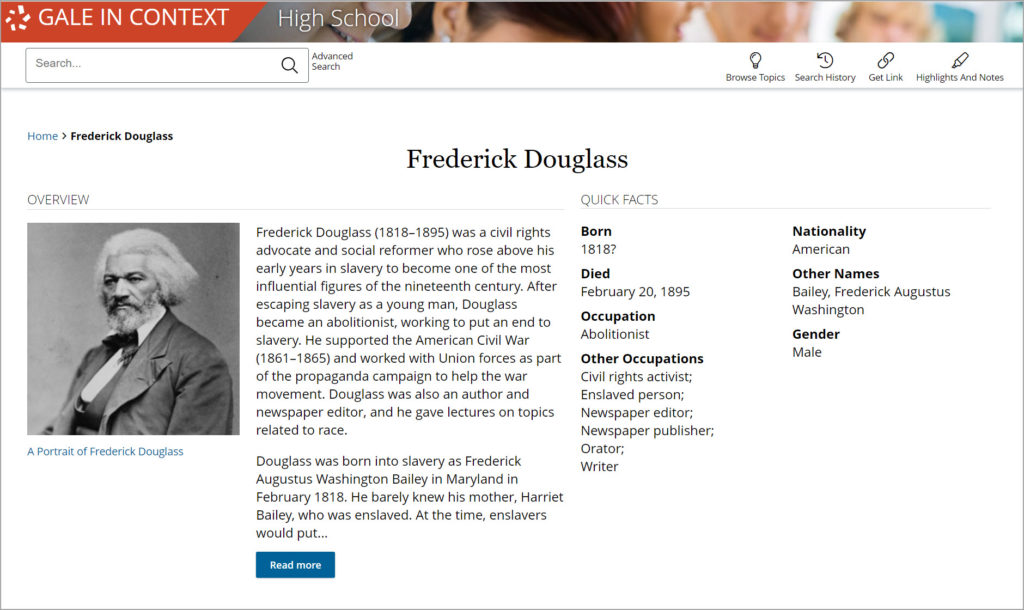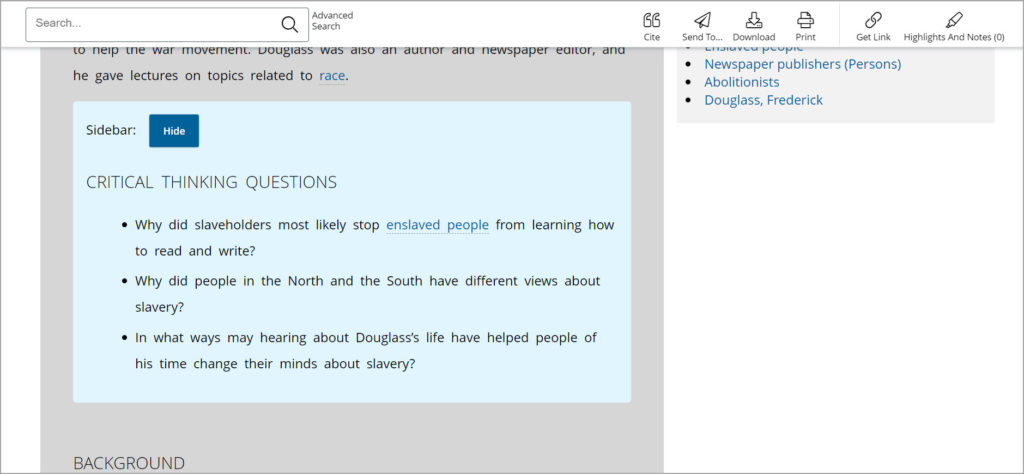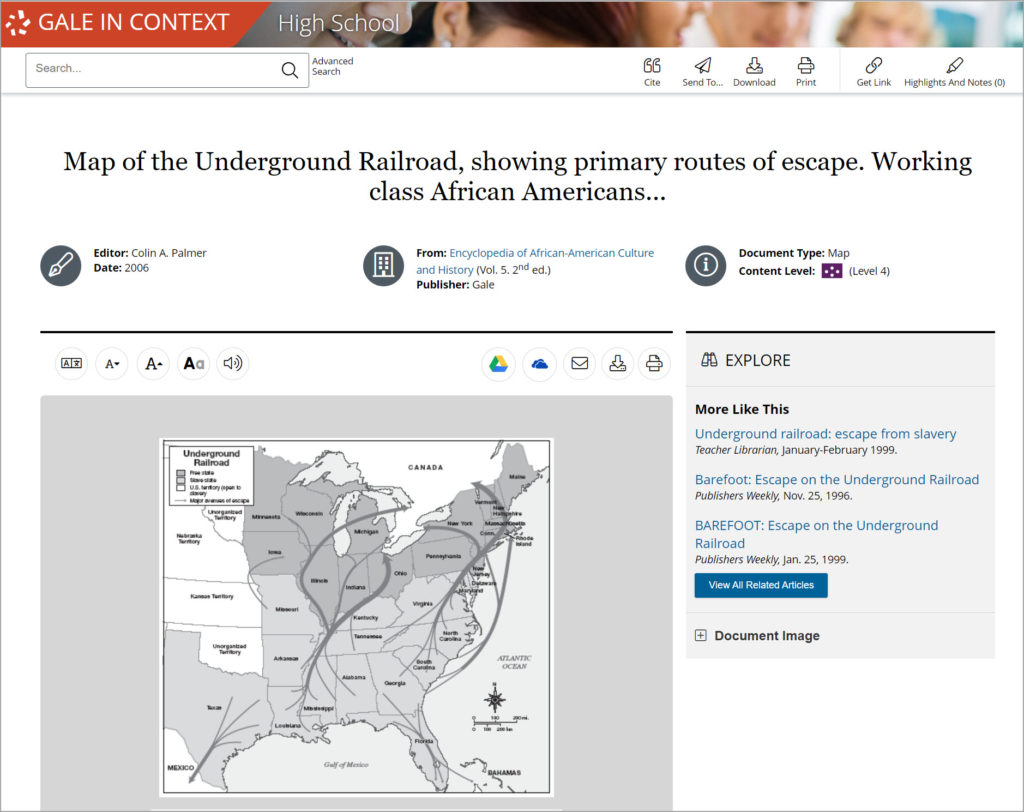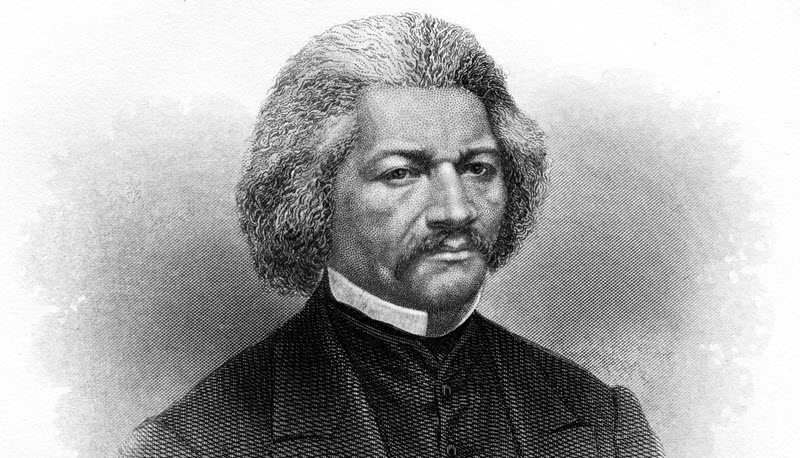| By Gale Staff |
Your high school students will undoubtedly recognize the name Frederick Douglass. After all, he was one of the most well-known abolitionists in U.S. history. This February, enrich your Black History Month (BHM) lesson plan with the inspirational story of this social reformer. While his exact date of birth was not recorded, Frederick Douglass chose to celebrate his birthday on February 14. His journey is one of perseverance and activism, and his life events will spark important questions and rich discussions among your high school students.
Share the History of Frederick Douglass
Born into slavery, Douglass knew little of his parents and was moved around to different households at a young age. Despite these challenges, he had an inextinguishable desire to learn. Sophia, the wife of a slaveowner, taught Frederick the basics of reading and writing even though it was illegal, and he continued to seek tutelage from any who would offer it. Despite beatings and abuse, he continued to read and teach, inspiring many to fight back against slavery and seek freedom.
Douglass eventually escaped slavery himself and became a passionate advocate for the antislavery movement and equal rights. He penned three autobiographies, which were not only instrumental in the nineteenth-century antislavery movement but continue to offer an important lens into the dark realities of slavery in U.S. history.
Douglass, at times, was a controversial figure, but with Gale In Context: High School, you can feel confident in the accurate, impartial information presented in his featured biographical entry alongside a whole collection of supplemental content. His legacy plays a critical part in U.S. history and lends itself to inspiring critical thinking about the country’s current reckoning with racial injustice.

Explore the Social Reformer’s Writing
A few of Frederick Douglass’s most important contributions were his autobiographies. Some people doubted the real horrors of slavery, and Douglass hoped to dispel any doubts by writing his own story. Your students can easily navigate to an overview of his work, finding a helpful, in-depth summary of Douglass’s writing and a lens into the slave narrative genre as a whole.
Gale In Context: High School resources include embedded hyperlinks for further reading, plus a collection of related articles. These recommendations can help spark your students’ natural curiosity, allowing a customized yet guided path to learning.
The Narrative of the Life of Frederick Douglass is widely available and relatively quick to read—it’s less than 100 pages. This work is a powerful piece in line with Black History Month’s themes. Consider assigning it to your English students or featuring it predominantly at the front of your library.
Discussion Idea: Ask your students why slaveholders would stop enslaved people from learning how to read. Guide them in a conversation that connects the dots between education, justice, and freedom. Find more critical-thinking questions in Gale In Context: High School to incite rich classroom discussions.

Discover the Lasting Impact of Abolitionists
The content within Gale In Context: High School features many supportive resources for high school instructors and librarians, including built-in discussion ideas and citation tools. History teachers can leverage a lesson on Frederick Douglass to launch a larger unit, and High School has hyperlinked paths toward those themes.
Once your students read about Frederick Douglass and his place in the U.S. antislavery movement, perhaps pivot the discussion into one of the topics in Gale’s “Learn More” section, such as Slavery and the Civil War or A Brief History of Jim Crow. Find dozens of vetted recommendations to further explore the important, albeit sensitive, history of race and U.S. history.
Activity Idea: Frederick Douglass achieved his freedom through and later served as a conductor for the Underground Railroad. As a class, explore primary sources, news pieces, magazine articles, and other media that expand on this secret network. Have your students study a general map of the Underground Railroad’s main routes. How was your region involved? Are there any railroad “stops” in your area? Encourage your students to complete a high school research project on the Underground Railroad’s presence in your state.

After studying Frederick Douglass and the larger context of his role in U.S. history, help your students consider what values of the abolitionist movement are still relevant today. Challenge them to learn more about the experience of Black Americans in the twentieth and twenty-first centuries. Since the abolishment of slavery up until today, Black Americans have been fighting for equity, representation, and the opportunity to share their lived experiences.
Celebrate Black History Month and its major figures with curated, up-to-date, and accurate content in Gale In Context: High School. If your institution isn’t a subscriber, you can explore more information online or contact your sales rep.

